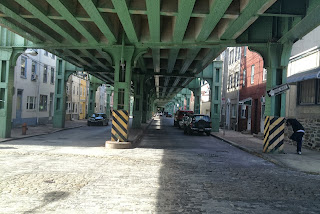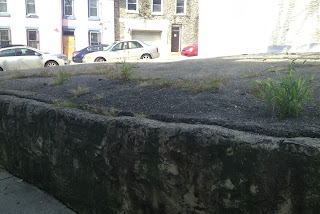As I walk to class, I notice the woman walking in front of me and think to myself, "This is my chance." My chance to follow this woman for a few minutes while she walks the same route I do to Drexel University's campus in order to complete the assignment. I could easily take out my phone, snap a few stealthy photos, and follow her to her destination. I could tell she was student due to her backpack. She had black tights, boots, and a medium-heavy jacket on with her hair in a ponytail. It would be an easy follow and a completed project; however, I could not find myself to take out my phone and watch. I also found myself not being able to stare at her anymore because I felt uncomfortable on her behalf. Why?
According to Jean Baudrillard, the art of following anyone is like a mirror. You lose the sense of yourself by "being absent" and following the other's path. The path means something to the creator, but it means nothing to the follower. While I followed that woman for a few minutes, I was too distracted with my own concerns and make-believing the woman's concerns that I was not able to think of the path I was following. While the follower shoots the photos, they are supposed to leave their path "untraceable." The follower was never there. This whole concept makes me feel uncomfortable. I am bothered that I am consuming her public space. I was following her path and I was supposed to document that path by taking a photo, but I was not able to bring myself to take those photos. I put myself within the path-creator's shoes. I would not like someone to take photos of me while being unaware of the follower's presence. I believe it is an invasion of personal space, even though she is walking on a public sidewalk and it's legal to do. But the pre-existing thought that I was going to follow this woman to her destination did not sit right with me because it felt too personal.
The woman's path was becoming untraceable by my footsteps. I was conquering her path and becoming her real-life shadow. Another idea that Jean Baudrillard brings up is that "shadowing" can bring an element of surprise. When the person turns around, do they notice that they have been followed? If I was being followed, I automatically think in terms of the dark side of following. Maybe I watched too many Law and Order episodes, but when I feel I am being followed, I automatically think of danger. Baudrillard compares the "shadow" as protection from the sun. However, I see the shadow as or the follower as an invader of your public space.
Mattress Factory: Traces of Memory by Chiharu Shiota
Monday, October 28, 2013
Tuesday, October 22, 2013
Green Public Space
What is Green Public Space?
When I first think about green public space, I immediately start to think in terms of the physical space of green in an urban city landscape. I think of the trees planted within the cement sidewalk and the patches of grass here and there. In terms of Philadelphia and green public space, I think of the undeveloped lots that lay around West Philadelphia and the random green parks placed within the city. That idea also brings up the topic of regulated and unregulated green public space. For one side, you have the lots between houses that most likely have not been touched by a human (or at least taken care of by a human) in a few months or even years. Then you have the regulated lots that have been taken care of or even cleaned out in order for economic profit (building a new house). On the other hand, you have the regulated parks that are taken care of every other week. These green public spaces encourage social interaction among people. These parks were strategically placed in order to encourage the community to interact with each other.In a way, green public space can be considered a variety of definitions. To the government, it most likely is defined as a space that can be for recreational or community purposes. To an environmentalist, it could be defined as a place to be reserved. But to the individual, it could be defined as anything they want it to be.
33rd Street between Mt. Vernon St. and Wallace St.
Manayunk Stairs
Istanbul & Philadelphia
Why is Istanbul, Turkey history considered cosmopolitan?
Istanbul has always been a major metropolis dating back centuries. It was a major city along the trade route between Europe and the Middle East. In a way, it's cosmopolitan because of it's status as a major cultural center throughout history. According to the reading "Street of Memory" by Amy Mills, Istanbul was a place with cosmopolitan identity because in the past, cultures blended, and where a variety of races and religions were able to live in coalition with each other. For instance, Istanbul's people can speak a variety of languages. Some of the cultures and religions that blended she mentions are Muslims, Christians, Jews, Ottomans, and Europeans. She quotes Roel Meijer saying Istanbul was "open undefined territory..."However, according to Streets of Memory, Istanbul has lost some it's cosmopolitan character due to "urbanization." She mentions how chain stores have kicked out small business owners, and the increase of private televisions within a household have had an impact on the sociocultural life outside. On the other hand, Istanbul will always have it's space that still has the old cosmopolitan history. It just depends on the individual who views that space. For instance, if I were to go visit Istanbul, I probably would notice the ancient architecture and streets. But if someone were to grow up there, they are probably used to the space and do not notice as much.
Why is Philadelphia, Pennsylvania's history considered democratic?
The idea of a democratic republic was born and was practiced for years in Philadelphia. The founding fathers all sat in Independence hall for several days voting and coming to terms and agreements on the natural rights of individuals and states by coming to a grand consensus on breaking all ties away from England. Philadelphia also demostrated it's democratic chops which is more important than the signing of the declaration of independence was when the Constitution was birthed here. Our republic needed help and once again the founders proved that a democratic method to passing legislation proved to help the rights of individuals. They sought to change a system of disunion, to the republic as we have it today. This city's is covered in democracy history and you can see it through the public space. Public monuments such as the Liberty Bell, statues in honor of those men who have signed those important documents throughout the city's landscape, the National Constitution Center.Tuesday, October 15, 2013
Public Space - Manayunk, Philadelphia
My Classmate's journey within Manayunk
2 blocks and turn Right (From left to right: Picture 1 and Picture 2)

1 block walk across the ttreet (Tattoo Shop) (Picture 3)
Turn left and walk under the train track, to the "Cresson Inn" into the alley (Picture 4)
Stop sign and turn left walk straight (Picture 5)
Go left to the empty store (4347 Zesit), handout and make friend.
My own journey around Manayunk:
Small alley way off of Cresson Street (Picture 7)
Walking farther down Cresson Street (Picture 8)
One of the first sights you may see when you get done walking down the Manayunk hills. (This particular street is Cresson St. and Cotton St.) (Picture 9)
View of Manayunk from stairs (almost in another neighborhood: Roxborough) (Picture 10)
When we were told we would meet in Manayunk to walk around, I was a little confused. I never thought of my hometown as a "space," I always thought of it as my neighborhood, and that's that. Then we were told to do a psychogeographic walk and I was even more confused. These walks consist of getting "lost"and drifting around to look at the space in a more "unpredictable" way. I am from this space, so drifting didn't seem logical to me and I was not able to complete the project because I was too caught up in my own thoughts. I kept thinking, "How am I supposed to look at this place a different way when I have been living here for years?" I always looked at it the same old way.I went back down to Main Street within Manayunk on a different day to see if I could complete the drifting project. As I walked around I started to notice small alley ways and the cobble stone streets. I didn't look at where I was going, I was looking at the details of the streets. I noticed the abrupt change of scenery from walking under the train tracks and coming out to see Main Street and notice all of the trees in thee far background (Picture 9). Another fresh image I never noticed was of the black empty tar spot that stuck out like a sore thumb to me on my walk (Picture 8). I walked by this empty a million times, and this walk was the first time I really noticed it. I started to notice things I never noticed before. This project has shed some new light into what Neighborhood Narratives is about. Each individual is going to have a different view of the urban city canvas, but it's up to yourself to create the element of visual portrayal versus physical portrayal.
Subscribe to:
Posts (Atom)
.jpg)

.jpg)




.jpg)



